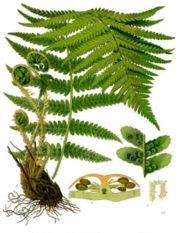
Dryopteris filix-mas
Encyclopedia
Dryopteris filix-mas is one of the most common ferns of the temperate Northern Hemisphere
, occurring throughout much of Europe
, Asia
, and North America
. It favours damp shaded areas and is common in the understory of woodlands, but is also found in shady places on hedge-banks, rocks, and screes. It is much less abundant in North America than in Europe.
 The half-evergreen leaves have an upright habit and reach a maximum length of 1.5 m, with a single crown on each rootstock. The bipinnate leaves consist of 20-35 pinnae on each side of the rachis
The half-evergreen leaves have an upright habit and reach a maximum length of 1.5 m, with a single crown on each rootstock. The bipinnate leaves consist of 20-35 pinnae on each side of the rachis
. The leaves taper at both ends, with the basal pinnae about half the length of the middle pinnae. The pinules are rather blunt and equally lobed all around. The stalks are covered with orange-brown scales. On the abaxial surface of the mature blade 5 to 6 sori develop in two rows. When the spore
s ripen in August to November, the indusium starts to shrivel, leading to the release of the spores.
This species hybridises easily with Dryopteris affinis
(Scaly Male Fern) and Dryopteris oreades (Mountain Male Fern).
to expel tapeworms, but has been replaced by less toxic and more effective drugs. The anthelmintic activity has been claimed to be due to flavaspidic acid, a phloroglucinol
derivative. The plant is sometimes referred to in ancient literature as Worm Fern. It is also grown as an ornamental fern in gardens.
Northern Hemisphere
The Northern Hemisphere is the half of a planet that is north of its equator—the word hemisphere literally means “half sphere”. It is also that half of the celestial sphere north of the celestial equator...
, occurring throughout much of Europe
Europe
Europe is, by convention, one of the world's seven continents. Comprising the westernmost peninsula of Eurasia, Europe is generally 'divided' from Asia to its east by the watershed divides of the Ural and Caucasus Mountains, the Ural River, the Caspian and Black Seas, and the waterways connecting...
, Asia
Asia
Asia is the world's largest and most populous continent, located primarily in the eastern and northern hemispheres. It covers 8.7% of the Earth's total surface area and with approximately 3.879 billion people, it hosts 60% of the world's current human population...
, and North America
North America
North America is a continent wholly within the Northern Hemisphere and almost wholly within the Western Hemisphere. It is also considered a northern subcontinent of the Americas...
. It favours damp shaded areas and is common in the understory of woodlands, but is also found in shady places on hedge-banks, rocks, and screes. It is much less abundant in North America than in Europe.

Rachis
Rachis is a biological term for a main axis or "shaft".-In zoology:In vertebrates a rachis can refer to the series of articulated vertebrae, which encase the spinal cord. In this case the rachis usually form the supporting axis of the body and is then called the spine or vertebral column...
. The leaves taper at both ends, with the basal pinnae about half the length of the middle pinnae. The pinules are rather blunt and equally lobed all around. The stalks are covered with orange-brown scales. On the abaxial surface of the mature blade 5 to 6 sori develop in two rows. When the spore
Spore
In biology, a spore is a reproductive structure that is adapted for dispersal and surviving for extended periods of time in unfavorable conditions. Spores form part of the life cycles of many bacteria, plants, algae, fungi and some protozoa. According to scientist Dr...
s ripen in August to November, the indusium starts to shrivel, leading to the release of the spores.
This species hybridises easily with Dryopteris affinis
Dryopteris affinis
Dryopteris affinis is fern native to western and southern Europe and southwestern Asia....
(Scaly Male Fern) and Dryopteris oreades (Mountain Male Fern).
Cultivation and uses
The root was used, until recent times, as an anthelminticAnthelmintic
Anthelmintics or antihelminthics are drugs that expel parasitic worms from the body, by either stunning or killing them. They may also be called vermifuges or vermicides .-Pharmaceutical classes:...
to expel tapeworms, but has been replaced by less toxic and more effective drugs. The anthelmintic activity has been claimed to be due to flavaspidic acid, a phloroglucinol
Phloroglucinol
Phloroglucinol is a benzenetriol. It is an organic compound that is used in the synthesis of pharmaceuticals and explosives. This molecule exists in two forms, or tautomers, 1,3,5-trihydroxybenzene, which has phenol-like, and 1,3,5-cyclohexanetrione , which has ketone-like character. These two...
derivative. The plant is sometimes referred to in ancient literature as Worm Fern. It is also grown as an ornamental fern in gardens.

